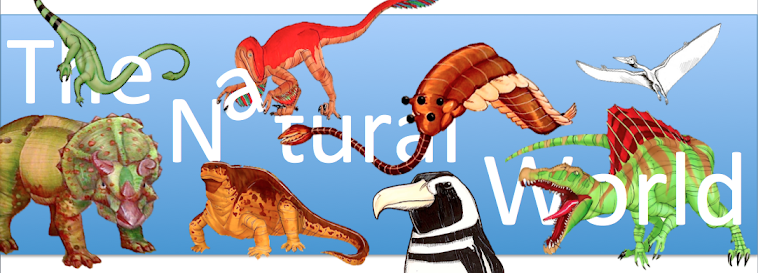1. The phytosaurs are the first of these "pesudosuchian" groups. Although at a glance they look pretty similar to the modern day Indian gharial, the phytosaurs lived in the Late Triassic, right around the time that dinosaurs were first evolving too, about 200-220 MYA. We still have nearly 150 million years before the appearance of modern crocodiles! As you can see below, the phytosaurs definitely resembled the later crocodilians in many ways, but they were different, too. Just look at how far back on the skull those nostrils were!
2. Our next pseudosuchian is one of my favorites, named Desmatosuchus. A member of the extinct group called the aetosaurs, Desmatosuchus was actually an herbivore! As you can see on the back of this animal, Desmatosuchus is yet another one of those fascinating creatures that has evolved dermal armor, similar to the armadillo and the ankylosaurs! The giant shoulder spikes of Desmatosuchus definitely look a whole lot like those of the ankylosaurs, and served a similar defensive purpose. If you traveled back to the Late Triassic period, you would have been able to find Desmatosuchus in the southern United States.
3. While Poposaurus definitely looks a lot like a dinosaur, just like Desmatosuchus and the ankylosaurs, this is simply another fascinating example of convergent evolution! Poposaurus, just like Desmatosuchus and the first dinosaurs, lived during the Late Triassic Period, about 225 million years ago. For whatever reason, it was the poposaurs and not the dinosaurs that went extinct at the end of the Triassic Period. Apparently, the Triassic town wasn't big enough for these two groups of bipedal reptiles.
4. Postosuchus, a member of another group of pseudosuchians called the rauisuchians, looked a lot like Poposaurus, as this critter also is thought to have been able to walk on its hind legs. Postosuchus and Poposaurus also both lived at the end of the Triassic, and both disappeared in the mass extinction event that jumpstarted the Jurassic. Apparently, when it was first discovered, Postosuchus was thought to be a tyrannosaur ancestor, an understandable mistake once you look at the skull of this creature!
5. This next crocodilian seems like a bizarre medley of different animals and, in some ways, it kind of is! Meet Dakosaurus, a member of a group of extinct crocodilians called the metriorhynchids. The metriorhynchids display numerous physiological adaptations that suggest they were quite comfortable in marine environments, such as paddle-like front limbs, hypertrophied nasal salt glands (presumably to help keep the body from getting an excess of salt), and a hypocercal tail.* Unlike many other crocodilians, the metriorhynchids evolved sharp, serrated teeth, similar to those seen in terrestrial predatory dinosaurs. These marine crocodilians also lost their dermal armor over the course of evolution, the tough, bony scales and scutes on the backs of modern day crocodiles that help defend them against attack from predators or other crocodilians. Presumably, this lack of dermal armor would have helped make the metriorhynchids even more hydrodynamic. Dakosaurus has been discovered in Europe, South America and Mexico, and lived during the Late Jurassic and Early Cretaceous.
*As you can probably tell from the complicated words used in these descriptions, the "hypertrophied nasal salt glands" and "hypocercal tail" are both direct quotes from the paper describing Dakosaurus (click HERE to check it out). I had a tough time determining the exact meaning of the term "hypocercal," but as I understand it, it is a condition seen in many extinct fish and other marine creatures, in which the vertebral column bends downwards in the tail, (as you can see in the picture of Dakosaurus above), as opposed to where the vertebral column bends upwards, or simply doesn't protrude very far into the tail to begin with. Amongst other creatures, the ichthyosaurs seem to have a very similar tail design, as you can see below. I'm not certain what, if any, the distinction is between hypocercal and reversed heterocercal; either way, this sort of tail definitely seems like it would be a good adaptation for swimming!
Works Cited:
Arizonasaurus. (n.d.). ReptileEvolution.com. Retrieved February 16, 2014, from http://www.reptileevolution.com/arizonasaurus.htm
Buchy, M. New Occurrence of the Genus Dakosaurus (Reptilia, Thalattosuchia) in the Upper Jurassic of North-Eastern Mexico, with Comments on Skull Architecture of Dakosaurus and Geosaurus. E. Schweizerbart'sche Verlagsbuchhandlung, 249, 1-8. Retrieved February 19, 2014, from http://www.ingentaconnect.com/content/schweiz/njbgeol/2008/00000249/00000001/art00001
Butler RJ, Brusatte SL, Reich M, Nesbitt SJ, Schoch RR, et al. (2011) The Sail-Backed Reptile Ctenosauriscus from the Latest Early Triassic of Germany and the Timing and Biogeography of the Early Archosaur Radiation. PLoS ONE 6(10): e25693. doi:10.1371/journal.pone.0025693
Carroll, R. L. (1988). Vertebrate paleontology and evolution. New York, N.Y.: W.H. Freeman and Company.
Cloudsley-Thompson, J. L. (1965). Ecology and Behavior of Mesozoic Reptiles. New York: Springer.
Hopson, J. A. The Functional Significance of the Hypocercal Tail and Lateral Fin Fold of Anapsid Ostracoderms. Fieldiana, Geology, 33. Retrieved February 19, 2014, from https://archive.org/details/functionalsignif335hops
Kischlat, E., & Lucas, S. G. (). A Phytosaur from the Upper Triassic of Brazil. JSTOR: Journal of Vertebrate Paleontology, 23, 464-467.
Naish, D. (2012, October 9). Awesome Sea-Going Crocodyliforms of the Mesozoic. . Retrieved February 16, 2014, from http://blogs.scientificamerican.com/tetrapod-zoology/2012/10/09/awesome-sea-going-crocodyliforms-of-mesozoic/
Peters, D. (2011, October 17). Pop Go the Poposaurs!. The Pterosaur Heresies. Retrieved February 16, 2014, from http://pterosaurheresies.wordpress.com/2011/10/17/pop-go-the-poposaurs/
Pol, D. An Unusual Marine Crocodyliform From the Jurassic-Cretaceous Boundary of Patagonia. Science AAAS, 311, 70-73. Retrieved February 19, 2014, from http://www.sciencemag.org/content/311/5757/70.full
Pol, D. An Unusual Marine Crocodyliform From the Jurassic-Cretaceous Boundary of Patagonia. Science AAAS, 311, 70-73. Retrieved February 19, 2014, from http://www.sciencemag.org/content/311/5757/70.full
Rutiodon. (2010, May 4). The Forgotten Archosaurs. Retrieved February 16, 2014, from http://forgottenarchosaurs.blogspot.com/2010/05/rutiodon.html
Switek, B. (2013, February 13). Poposaurus, Postosuchus, and the Dinosaur Mimic Croc Walk. Phenomena. Retrieved February 16, 2014, from http://phenomena.nationalgeographic.com/2013/02/21/poposaurus-postosuchus-and-the-dinosaur-mimic-croc-walk/
Wedel, M. (2007, January 1). Phytosauria. University of California Museum of Paleontology. Retrieved February 16, 2014, from http://www.ucmp.berkeley.edu/taxa/verts/archosaurs/phytosauria.php
Wedel, M. (2007, January 1). Pseudosuchia. University of California Museum of Paleontology. Retrieved February 16, 2014, from http://www.ucmp.berkeley.edu/taxa/verts/archosaurs/pseudosuchia.php

No comments:
Post a Comment